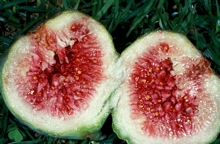 |
A common concern among humans is
whether we eat fig wasps when we consume figs. The short answer is yes
for dried figs and usually no for fresh figs. The fig species that is
eaten is the domesticated fig
Ficus carica a dioecious species, which has been in
cultivation for about 11 000 years, although an understanding of the
role that the pollinating wasp
Blastophaga psenes plays in the reproduction of the cultivated fig
(the process of caprification) is only a relatively recent
elucidation. This fig species occurs naturally in the
Mediterranean region, but is also cultivated in this area as well as in
various other parts of the world where there is a suitable climate, such
as California and South Africa (Kjellberg, F. van Noort, S, Rasplus JY.
In press). |
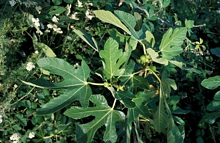 |
The process of caprification where oviposition
by the pollinator
Blastophaga psenes is required to ensure successful ripening of the
female figs still plays an important role in the cultivated fig
industry. In natural wild populations of
Ficus carica, figs suitable for consumption are produced on
female trees only if they are pollinated by
Blastophaga psenes, released from figs borne on male trees, which
contain both wasps and pollen, and are usually not eaten. The male figs
that produce the wasp pollinator were called "caprifigs" because they
were not eaten and were said to be “only good for the goats”. Commercial cultivation of fresh figs for the consumer market
usually centres on parthenocarpic cultivars, i.e. varieties that have
been artificially selected for during the long association of
cultivation by humans. These varieties do not need pollination to
produce fruit (parthenocarpy). Fig trees will normally abort their fig crop if the
figs are not pollinated as the figs are then an energy cost with no
benefit to the tree. This artificial selection has resulted in cultivars
that produce ripe figs that have not been entered by wasps, and as a
result do not form seeds making the fresh fig sweeter and softer. Since
no pollination is involved propagation of these cultivars has to be via
the process of cuttings (truncheons). This mode of vegetative
propagation has allowed for the anthropogenic expansion of the species’
distribution to non-native regions across various parts of the world,
and may have been one of the earliest forms of agricultural
domestication of a plant species, predating cereal production (Kjellberg,
F. van Noort, S, Rasplus JY. In press). Figs
that are grown for
dry fig production are usually cultivars that need pollination
(caprification) such as the
Turkish Sari Lop or Smyrna figs, which have a nutty flavour
and contain seeds, in contrast to the sweeter fruit of the
parthenocarpic varieties that are much softer without seeds
(Armstrong, 1988; 2010; Tribolet, 1912). The fruiting phenology of these
Smyrna cultivar is the same as that of wild female trees. The
pollinator has hence also been introduced to various parts of the world
where
Ficus carica is cultivated to enable the production and supply
of figs to the dry fig market (Mars, 2003). In many regions, however,
these cultivars are being progressively replaced by cultivars that do
not require pollination in order to avoid sanitary problems, such as
transmission of internal rot fungus by the pollinators, and costs (Kjellberg,
F. van Noort, S, Rasplus JY. In press). |
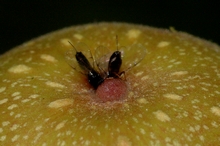 |
Female fig wasp pollinators enter the fig through
the ostiole (opening at the apex of the fig) to pollinate the
flowers and to lay their eggs down the style into the ovary of the
flower.
See lifecycle. However, Ficus carica is a functionally dioecious species,
which means that the male and female reproductive functions of the
species are
separated between individual trees, with some trees being female and others male.
Female trees
produce seeds in the figs and no wasps, whereas male trees produce
a few seeds but mostly wasps. The wasps then load up pollen before
dispersing from the fig they have bred in and hence perform the male
function for the species.
How does this happen? |
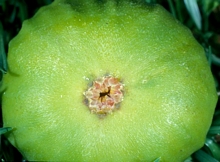 |
If figs from female trees of cultivars such as the Smyrna fig that do require pollination are used in fig
production there is a possibility of eating wasps because the foundress
females that entered the fig to pollinate the flowers often do not
manage to exit the fig again. On occasion the female wasps
will escape from the fig they entered.
The wasps do not manage to breed in the fig, because the floret styles
are too long for the female's ovipositor to reach the ovule to lay an
egg, and only seeds are produced as a result of her pollination of the
stigmas, with these figs performing
the female function for the species. |
|
In California and South Africa the
Caprifig trees (male trees) of
Ficus carica produce three caprifig crops per year: the summer
profichi crop (with galls and male flowers); an autumn mammoni
crop (galls and abortive male flowers); and an overwintering mamme
crop (galls and abortive male flowers) where the figs only mature the
following spring (Armstrong, 1988; Giliomee et al 2007; Tribolate,
1912). Pollen laden female fig wasps leaving the profichi crop
enter the mammoni crop and oviposit into the ovules; the
resulting wasp progeny leaving this crop then oviposit in the mamme
crop and those wasps then complete the cycle by ovipositing in the
profichi crop again. Pollen from the profichi crop is used to
pollinate the Smyrna (Calimyrna) orchards in mid-summer,
as the other two crops do not produce pollen in the figs (Armstrong,
2010). The wasps survive the cold winter months as larvae in the
overwintering mamme crops. Female trees produce two fig crops per
year: the breba crop, ripening in early summer; and the main
second crop ripening in autumn. The process of caprification can aid the
transmission of internal rot fungus or endosepsis (Fusarium
moniliforme var. fici (Caldis, 1927) from the male caprifigs
to the female Smyrna figs (Armstrong, 2010; Caldis, 1927; Davey and
Smith, 1933; Michailides and Morgan, 1998; Wohlfarter et al 2011).
Intervention is required to avoid this transmission. In California the
overwintering mamme crop is harvested in spring and the figs are
treated with a fungicide after being split open (Armstrong, 2010). They
are then re-introduced to the orchards so that the emerging wasps can
enter the profichi crop. This fungus can result in considerable
crop losses, with hot and humid conditions being ideal for rapid
transmission (Caldis, 1927; Michailides and Morgan, 1998; Wohlfarter et
al 2011; Kjellberg, F. van Noort, S, Rasplus JY. In press). |
|
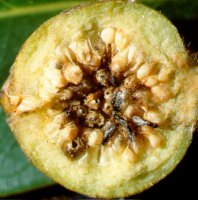 |
Wild figs are
also very nutritious and
eaten by many indigenous people. In these cases the fig wasps
that have not departed from the fig they bred in are consumed along with
the fig. Most of the fig wasps will have left the fig before it ripens
and becomes attractive to frugivores, but many species have wingless
males which die and remain within the fig cavity. There are also
nematode worms that are specific to fig wasps and a host of other fungal
organisms residing within the fig cavity of wild figs, but these don't
appear to have any negative effect on human health. |
Links
|
Ficus carica and its pollination (Kjellberg & Lesne
2020).
Purdue University's
NewCrop site (For information on
varieties, cultivation and uses).
The
Calimyrna fig and its pollinator wasp (Armstrong, 2010). |
References
|
Armstrong, W.P. 1988.
The calimyrna fig and its wasp. California Garden 79,
135-138.
Armstrong, W.P. 2010. Calimyrna Figs in California.
Available at:
https://www2.palomar.edu/users/warmstrong/pljune99.htm
Caldis, P.D. 1927. Etiology and
transmission of endosepsis (internal rot) of the fruit of the
Fig. Hilgardia 2, 287–346.
Davey, A.E. and Smith, R.E. 1933. The
epidemiology of fig spoilage. Hilgardia 7, 523–551.
Gaaliche, B. Trad, M. Mars, M. 2011.
Effect of pollination intensity, frequency and pollen source on fig (Ficus carica L.) productivity and fruit quality.
Scientia Horticulturae
130 (4): 737-742.
Giliomee JH, Venter E, Wohlfarter M. 2007.
Mediterranean black fig fly, Silba adipata McAlpine (Diptera:
Lonchaeidae), recorded from South Africa. African
Entomology 15: 383-384.
https://doi.org/10.4001/1021-3589-15.2.383
Kjellberg, F. and Lesne A. 2020.
Ficus carica and its pollination.
https://hal.archives-ouvertes.fr/hal-02516888
Kjellberg, F. van Noort, S, Rasplus JY. In press. Fig wasp
and pollination. In Sarkhosh, L. Ferguson, A.M. Yavari
(Editors): The Fig: Botany, Production and Uses. CAB
International.
Mars, M. 2003. Fig (Ficus carica L.) genetic
resources and breeding. Acta Hortic. 605, 19–27.
http://dx.doi.org/10.17660/ActaHortic.2003.605.1
Michailides, T.J. and Morgan, D.P. 1998. Spread of
endosepsis in Calimyrna fig orchards. Phytopathology, 88,
637–647.
Stover, E., Aradhya, M., Ferguson L. & Crisosto, C.H.
2007. The fig: Overview of an ancient fruit.
HortScience 42:1083–1087.
Tribolet, I. 1912.
Caprification of smyrna figs. Agricultural Journal of the
Union of South Africa 3: 247-256.
Wohlfarter M, Giliomee JH, Venter E, Storey S.
2011.
A survey of the arthropod pests and plant parasitic nematodes
associated with commercial figs, Ficus carica (Moraceae),
in South Africa. African Entomology 19: 165-172.
https://doi.org/10.4001/003.019.0118 |
Credits
|
Photographs ©
Simon van Noort (Iziko Museums of South Africa). |
|